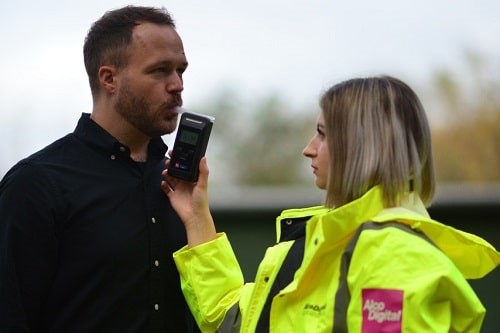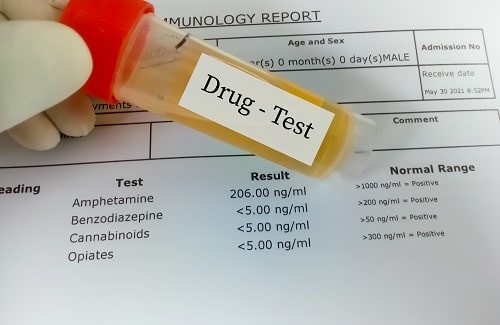Drug and alcohol testing can play a vital role in ensuring the safety of everyone at work, but it’s crucial the reasons for testing are properly explained to staff, and the correct testing equipment is used.
Features
Drug and alcohol testing at work: getting started
One way or another, we all have to deal with risks in the workplace. Whether these risks are trivial at best or potentially life-threatening, a crucial element to ensuring a safe working environment and helping to limit the potential for risks is having a comprehensive policy for drug and alcohol testing. This article will explain why drug and alcohol testing is useful and the benefits it offers, and provide general advice on introducing a policy, available testing methods and equipment, and managing test results.
Some statistics
Drug and alcohol misuse is a serious societal problem, but it impacts the workplace as well, as a recent report by the Considerate Constructors Scheme (CCS) found that 59 per cent of respondents agree that drugs and alcohol are issues of concern. There is also a significant economic impact of substance misuse, with lost productivity due to alcohol in the UK costing around £7.3 billion per year in an impact assessment paper produced by the Institute of Alcohol Studies (IAS).
 There is no one single, correct way of introducing a testing policy, especially as requirements will vary from company to company. Photograph: AlcoDigital
There is no one single, correct way of introducing a testing policy, especially as requirements will vary from company to company. Photograph: AlcoDigital
The same IAS report also included a statement from the International Labour Organization that, while there are no precise figures for the number of workplace accidents attributable to alcohol, it is estimated that up to 40 per cent of accidents at work involve or are related to alcohol use.
Why testing is useful
Having a drug and alcohol testing policy in place will not just help employers tackle these concerns, but will also ensure that companies and industries are operating within the law. The Health and Safety at Work Act 1974 states that it is the “duty of every employer to ensure… the health, safety and welfare” of all employees at work, and complying with this duty should form the basis of a business’s approach to testing in the workplace.
Implementing a testing policy could result in a reduction in accidents and poor productivity in the workplace, but a report into misuse of drugs and alcohol by the Chartered Institute of Personnel and Development (CIPD) found that even infrequent drug and alcohol use can impact the workplace in less obvious ways. These range from problems with punctuality to having a negative impact on team morale, company reputation and customer relations.
The CIPD also highlights how some people may not show obvious signs of substance misuse, as high-functioning substance users will tend to pass impairment tests the majority of the time (think of walking in a straight line, coordination exercises, etc.), and therefore might not exhibit behaviours that could lead to a reasonable suspicion that a formal screening test needs to be conducted to check for signs of alcohol or drug misuse.
No matter how high functioning someone may be, having impairing substances in the body is incredibly dangerous and can be detected by having comprehensive testing methods in place (random testing in particular) with suitable testing equipment.
 When drawing up a policy, employees will need to be informed on how and when testing will take place. Photograph: iStock
When drawing up a policy, employees will need to be informed on how and when testing will take place. Photograph: iStock
Implementing a drug and alcohol testing policy
There is no one single, correct way of introducing a testing policy, especially as requirements will vary from company to company. Some organisations may feel that they don’t have serious drug-related issues, which is entirely valid when you consider the people who are more likely to consume illicit drugs – around 20 per cent of people aged 16–24 have admitted to cannabis usage in recent years; however, this drops to 7.8 per cent when the age range is expanded to those aged 16–59 years old.
However, there are specific industries that would benefit from testing. For instance, the CCS cited data suggesting that 20–30 per cent of workplace accidents can be associated with alcohol in safety-critical industries like construction, and that seven out of the 10 professions with the highest drink or drug driving rates in 2016 were part of the building trade.
When drawing up a policy, employees will need to be informed on how and when testing will take place. The main testing methodologies to consider using are:
- Post-incident/For cause testing: Conducting a test after an ‘event’ has happened (the term ‘event’ can be vague, may include accidents but also near misses)
- Random testing: Randomly selecting an individual/group of employees for testing (however, employers should never select names/employee numbers from a list – random number generators are best used to ensure a random selection)
- Reasonable suspicion testing: Testing an individual/group of staff members based on a report made against them or your own suspicion – for example, the smell of alcohol, a change in behaviour, etc.
- Induction testing: Pre-employment screening that sets a precedent
- Consequential/forewarned: Warning staff that testing will increase on a particular day (for example, following parties, festivals, sports events).
Before testing takes place, it is crucial that employees are informed when the policy is being introduced, as well as making sure that updates and changes to the policy are communicated just as clearly.
The CCS recommends that resources and awareness materials should be accessible to all, which may include staff meetings, posters, handouts, information summaries and providing staff with links to other sources of information.
 Connor Deith: "People consume drugs and alcohol for all sorts of reasons that aren’t always within their control."
Connor Deith: "People consume drugs and alcohol for all sorts of reasons that aren’t always within their control."
The website Talk to Frank is a reliable source of facts about drugs and addiction and has relevant news pieces for those who are interested in learning more about the substances that a testing policy may cover.
Generally, it is recommended that 10 per cent of the workforce is tested per month for alcohol and around two per cent for drugs, but this will always depend on a company’s specific requirements. An employer may want to test for both drugs and alcohol or just one, but regardless of who will be tested and when, it is essential to have an excellent understanding of the types of equipment that are suitable for workplace testing.
Breathalysers
To make sense of the range of breathalysers available, there are generally three main criteria to consider: the approval rating, testing methods (i.e., the types of test a breathalyser can do), and the sensor it uses.
As a minimum, if a device has the specific European approval rating of EN–15964, then it has achieved the accuracy and reliability required for European approval as a professional grade breathalyser and can be used in workplaces in the UK. Some breathalysers feature the same hardware as Home Office-approved units used by the police, but at the very least, EN–15964 approval is sufficient for use in the workplace.
There are two types of test a breathalyser can carry out: screening and evidential tests. Screening tests are a rapid sampling method for detecting the presence of alcohol in exhaled breath. The main advantage of this testing method is that it’s quick, allowing up to 100 people to be screened within 10 minutes.
The results are either ‘Pass’ or ‘Fail’, but bear in mind that while a ‘Fail’ result could indicate alcohol in someone’s breath, it could also be due to environmental factors (for example, hand sanitiser, anti-freeze and mouthwash could all be picked up in a screening test).
Any non-negative screening test therefore should be followed up with an evidential test, which requires the use of a mouthpiece. This removes the potential for contaminants in the surrounding air from affecting test results, but it also ensures a full sample of deep-lung breath is collected, which is the air closest to the gut and most representative of alcohol content in the system (i.e., the bloodstream).
Evidential test results are usually displayed in micrograms (µg) per 100ml of breath (for instance, the English drink-driving limit is 35µg/100ml). These are the test results an employer can safely take disciplinary action on, as they will have correctly determined an exact reading of alcohol content in the individual’s breath.
Electrochemical sensors are the gold standard for breath testing as they provide greater accuracy and durability than semi-conductor alternatives. All breathalysers with an electrochemical sensor require regular calibration to ensure the device stays within its specified tolerances for accuracy and reliability. Some units will need calibrating twice a year or every 500 tests, while others will be stable for 12 months or 5,000 tests. Breathalysers must be kept within their calibration period, as test results obtained outside of this period are susceptible to legal challenge.
On the more affordable end, several breathalysers are available that cost around the same as a full tank of vehicle fuel. These devices are typically marketed as ‘personal breathalysers’ and can easily fit in a glove box, but they are just that; they are designed for personal use only.
Personal breathalysers usually don’t come with the appropriate approval rating nor the more accurate electrochemical-type sensor that professional grade breathalysers possess. Single use or disposable breathalysers are also not suitable for workplace testing for the same reasons.
Drug testing
There are several ways of detecting the presence of drugs and their metabolites in the body – they can be found in the blood, hair and sweat, but the two most common testing methods used in the workplace are saliva and urine.
When a drug is ingested, it first works its way into the bloodstream, where it’s also detectable in the saliva through the white blood cells that exist in oral fluid. Once filtered out of the bloodstream, metabolites are deposited in the urine, where, depending on how much of a given drug was consumed and for how long, metabolites can be detectable in the urine for days or weeks after consumption.
Therefore, there is a key difference between saliva and urine testing – saliva testing will test for drugs that are still in the bloodstream and therefore could be having an impairing effect on the individual, whereas urine testing detects substances that were recently in the system, but were not having impairing side effects at the time the sample was taken.
 High-functioning substance users will tend to pass impairment tests the majority of the time. Photograph: iStock
High-functioning substance users will tend to pass impairment tests the majority of the time. Photograph: iStock
Drug screening kits are sophisticated pieces of equipment that can screen for commonly consumed illegal substances like THC (the primary psychoactive cannabinoid extracted from the cannabis plant) and cocaine at mere nanograms per millilitre of saliva.
However, for evidential results, a follow-up procedure needs to be carried out to obtain samples that need to be sent off to an accredited laboratory for further analysis. As with alcohol testing, drug screening test results will only be ‘negative’ or ‘non-negative’ (not ‘positive’ technically speaking, as you cannot obtain evidential proof of the presence of drugs with screening kits alone) and must not be used for taking any disciplinary action. However, the individual can be suspended after a non-negative screening test while the employer awaits the lab results.
Managing test results
When faced with positive evidential test results, making the decision of what to do next can be daunting. While it could mean that an individual ends up being suspended or even dismissed, it must be remembered that it is an employer’s duty to maintain a safe working environment for all staff.
Test results that prove the presence of impairing substances which could endanger staff members, reputations and the general public alike should of course be taken seriously, but that’s not to suggest that this is where the issue should end.
The CIPD found that only one-third of employers provide information for employees about sources of support for drug and/or alcohol-related problems, so providing staff with educational material or pointing them towards sources for help should also be taken into account as part of a comprehensive testing policy.
People consume drugs and alcohol for all sorts of reasons that aren’t always within their control, so rather than ignoring the issues behind substance use entirely, an employer should consider providing staff with options for long-term help and advice. Organisations like Broadway Lodge, Betel UK and Change Grow Live all offer services to help people improve their health and wellbeing, and the Salvation Army and Samaritans both have 24/7 helplines for anyone who needs more immediate assistance.
Conclusion
This article has sought to highlight the benefits of drug and alcohol testing in the workplace, as well as giving general advice on some more specific topics. Substance testing at work isn’t without its challenges, but when implemented and managed well, it is undoubtedly a crucial part in maintaining a safe working environment for all involved.
Connor Deith is Sales and training executive at AlcoDigital
For more information and advice see:
breathalyzer.co.uk
FEATURES

Pursuing workplace wellbeing through authentic leadership
By Dr Audrey Fleming, British Safety Council on 26 April 2024
By being open, honest and vulnerable in their interactions at work – and genuinely seeking and valuing the input of employees – leaders can develop a workplace atmosphere where trust and respect flourish, in turn supporting the wellbeing, engagement and performance of their teams.

Out in the field: why lone worker monitoring is key
By Rebecca Pick, Pick Protection on 26 April 2024
People working away from a fixed base out in the field may need to quickly summon assistance in an emergency, but it’s important to choose the right communications and alarm technology for their needs.

Why line managers play a vital role in workplace wellbeing
By Marcus Herbert, British Safety Council on 03 September 2023
The behaviours of line managers can have a positive or negative impact on employee health, wellbeing and engagement, so it’s vital managers get staff feedback on whether their management style is supportive or negative, and have regular check-ins so workers can raise concerns about their wellbeing.



